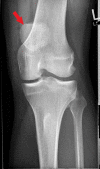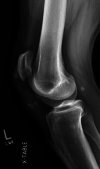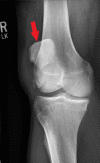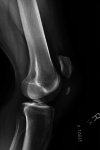Simultaneous Bilateral Patellar Tendon Rupture in a Young Adult Male: A Case Report and Review of the Literature
- PMID: 33133819
- PMCID: PMC7586418
- DOI: 10.7759/cureus.10649
Simultaneous Bilateral Patellar Tendon Rupture in a Young Adult Male: A Case Report and Review of the Literature
Abstract
A bilateral patellar tendon rupture is extremely rare and has only been documented in case reports. Although the etiology remains unknown, predisposing factors include steroid usage, systemic diseases, and tendinopathies. In the present case, a healthy 33-year-old male with a prior history of bilateral patellar tendonitis and a diagnosis of Osgood-Schlatter disease during adolescence experienced simultaneous bilateral patellar tendon rupture after playing volleyball. He underwent bilateral patellar repair without complications. In the absence of trauma, spontaneous bilateral patellar tendon ruptures are associated with several predisposing factors, including systemic diseases, prior corticosteroid or fluoroquinolone usage, and history of tendinopathy. Injuries can be classified based on the location of the rupture. Bilateral patellar tendon ruptures can be misdiagnosed due to the rarity of cases and the lack of a normal comparative knee. Radiographic techniques can aid in the diagnosis, leading to early surgical treatment and improved outcomes. Early diagnosis and prompt surgical repair contribute to good functional outcomes in this potentially debilitating injury pattern.
Keywords: bilateral; knee extensor mechanism; osgood-schlatter; patellar tendon rupture; tendonitis.
Copyright © 2020, Moy et al.
Conflict of interest statement
The authors have declared that no competing interests exist.
Figures




References
-
- Bilateral patellar tendon rupture without predisposing systemic disease or steroid use: a case report and review of the literature. Kellersmann R, Blattert TR, Weckbach A. Arch Orthop Trauma Surg. 2005;125:127–133. - PubMed
-
- Bilateral simultaneous infrapatellar tendon rupture: support for Davidsson's theory. Splain SH, Ferenz C. https://pubmed.ncbi.nlm.nih.gov/3050816/ Orthop Rev. 1988;17:802–805. - PubMed
-
- Fluoroquinolone-associated bilateral patellar tendon rupture: a case report and review of the literature. Stinner DJ, Orr JD, Hsu JR. Mil Med. 2010;175:457–459. - PubMed
-
- Bilateral patellar tendon ruptures without predisposing systemic disease or steroid use: a case report and review of the literature. Sibley T, Algren DA, Ellison S. Am J Emerg Med. 2012;30:263–265. - PubMed
Publication types
LinkOut - more resources
Full Text Sources
